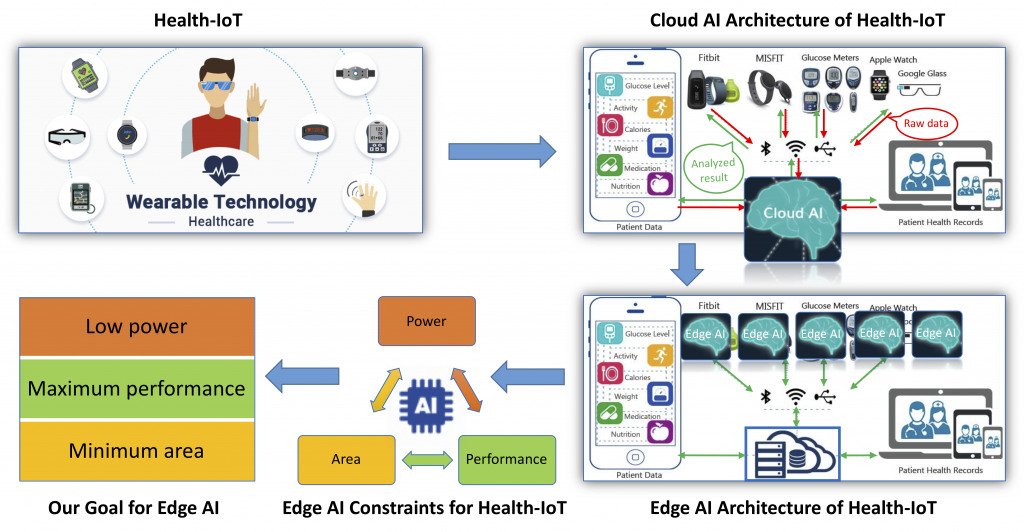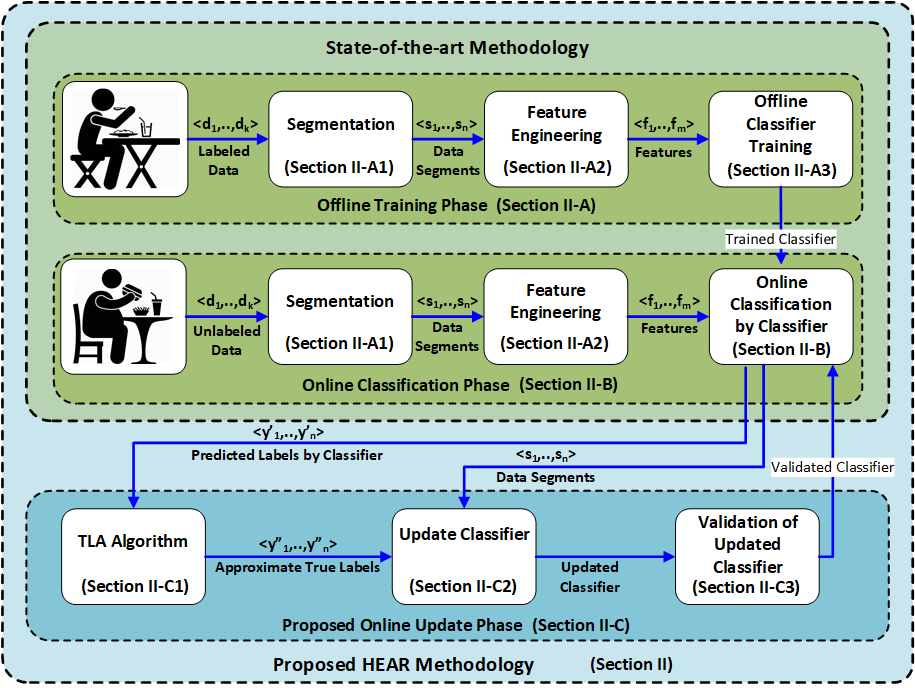Research Area 1: Edge AI for Health-IoT
Nafiul Rashid (Contact Person)
Health-IoT mostly refers to different wearable devices (smart watches, glucose meters, smart glasses) used for health monitoring. These wearable devices are connected to mobile phones/cloud via Bluetooth/ WiFi/ sometimes even with cables. Daily use of these wearable devices generates enormous amounts of raw data. Usually, those raw data are offloaded to cloud for further processing also known as ‘Cloud Computing’ or ‘Cloud AI’.
However, Offloading the raw data from the edge to the cloud has the following drawbacks –
a) Higher Energy Consumption: Communicating the enormous amount of raw data from edge to cloud increases energy consumption. Oftentimes the energy consumption for communication of raw data is way higher than processing the data on the edge and then sending the processed result to the cloud.
b) Increased Latency: Offloading the raw data from edge to the cloud for processing would introduce latency which might be undesirable for wearable applications that require real-time monitoring or feedback.
c) Breach of Privacy: Moreover, offloading the raw data to the cloud is vulnerable to the breach of privacy of the individuals. Malicious intermediaries may exploit that information which may make users uncomfortable using the wearable devices in the first place.
The aforementioned drawbacks advocate for the adoption of ‘Edge Computing’ or ‘Edge AI’ architecture where the raw data from the wearable devices will be processed at the edge. This will allow the reduction of communication energy consumption, decrease of latency, and will make the system more robust to the breach of privacy. The edge computing usually involves the use of various machine/deep learning algorithms to process and analyze the raw data. However, the small form factor of the edge devices introduces constraints on the computing capabilities in terms of power, performance, and area. Therefore, we need to design and develop methodologies for energy-efficient and low-power machine/deep learning algorithms to make them suitable for edge computing. Our goal is to ensure maximum performance with minimum energy while satisfying the memory constraint of the wearable device. The following figure summarizes the research focus of our lab in this area.

In one of our works, we propose a methodology for Myocardial Infarction (MI) detection on wearable devices. MI also known as ‘Heart Attack’ is a fatal heart disease that is a leading cause of death. The silent and recurrent nature of MI requires real-time monitoring on a daily basis through wearable devices. Real-time MI detection on wearable devices requires a fast and energy-efficient solution to enable long term monitoring. Therefore, we propose an MI detection methodology using Binary Convolutional Neural Network (BCNN) that is fast, energy-efficient and outperforms the state-of-the-art work on wearable devices. We validate the performance of our methodology on the well known PTB diagnostic ECG database from PhysioNet. Evaluation on real hardware shows that our BCNN is faster and achieves up to 12x energy efficiency compared to the state-of-the-art work. The following figure demonstrates our proposed MI detection methodology on wearable devices. This work is accepted to be published in 42nd IEEE EMBC, 2020.

- A short video presentation on our work on ‘Energy-efficient Real-time Myocardial Infarction Detection on Wearable Devices’ is given below:
In another work, we address the problem of continuous change in the eating habits of a person for food intake monitoring applications. We propose an online learning methodology called Human Eating Activity Recognition (HEAR) by introducing an online update phase. We also design an algorithm to be used in the online update phase that provides approximate true labels for the new data. Moreover, we also design a wearable neckband as the edge device to capture eating activity data (Chewing, Swallowing, Talking, and Idle) in a lab environment. Through a detailed experimental evaluation on 12 users, we show that an Online Learned Neural Network (OLNN) classifier using our HEAR methodology performs better than any state-of-the-art offline trained classifier. We also demonstrate that our OLNN classifier is energy efficient compared to the competitive offline trained classifiers. This work is accepted to be published in IEEE IoT Journal, 2020 (IF: 9.515). The following figures show an overview of our proposed HEAR methodology and the wearable neckband designed in our lab.


Research Area 2: Battery Management System
Electric Vehicles (EVs) have been accepted as a sustainable solution and a new paradigm of transportation for (non-)commercial purposes. However, there are major design challenges with EVs which hinder their development and proliferation. Degrading battery capacity (battery lifetime) and limited driving range are the major challenges of making the EVs economical for everyday usage. The above design challenges are mainly due to the specific battery characteristics and behavior. Although researchers have succeeded to improve the battery energy density, the challenges still remain. Moreover, the design constraints on the size, weight, and cost of the battery packs restrict the stored energy for the EV. Our research works involve battery management systems of EV considering a wide range of design constraints.
In one of our works, we propose an automotive climate control methodology that is aware of the battery behavior and performance while maintaining the passenger’s thermal comfort. In our methodology, battery parameters and cabin temperature are modeled and estimated, and the HVAC utilization is optimized and adjusted with respect to the electric motor and HVAC power requests. Therefore, battery stress reduces while the cabin temperature is maintained by predicting and optimizing the system states in the near future. We have implemented our methodology and compared its performance to the state-of-the-art in terms of battery life improvement and energy consumption reduction. The following figure depicts our work on climate aware battery management systems.

- A short video presentation on our work on optimization of battery management unit of Electric Vehicle is given below:
Research Area 3: Demand Side Energy Management and GridMat
Current distribution grid with various multi-domain and multi-physics components (power, market, weather, buildings, control, communication, software, embedded hardware, sensors, etc.) is an interesting example of cyber-physical system. In this research area, our primary focus is to develop technology and innovative solutions for demand side energy management including: 1) hierarchical, distributed, agent-based control algorithms for commercial/residential/industrial buildings and microgrid, 2) modeling and simulation capability including both cyber and physical components (cyber-physical co-simulation) of the demand side distribution grid, 3) electronic design automation tool design for CPES, etc. The figure below shows an exemplary residential microgrid example.

The basic objective of demand side energy management is to match the supply and demand. An example of matching supply and demand during off-peak time between 12 AM and 5 AM is shown below. In this example, electricity is stored in various forms, e.g. thermal, chemical (battery), potential energy (pumped-storage hydroelectricity), etc.
- A short video presentation on our work on demand side energy management of a smart grid is given below:
See our work on the following link for further details: https://aicps.eng.uci.edu/research/CPES/
To learn more about our GridMat Tool Visit: https://aicps.eng.uci.edu/research/CPES/Tools/GridMat.htm
